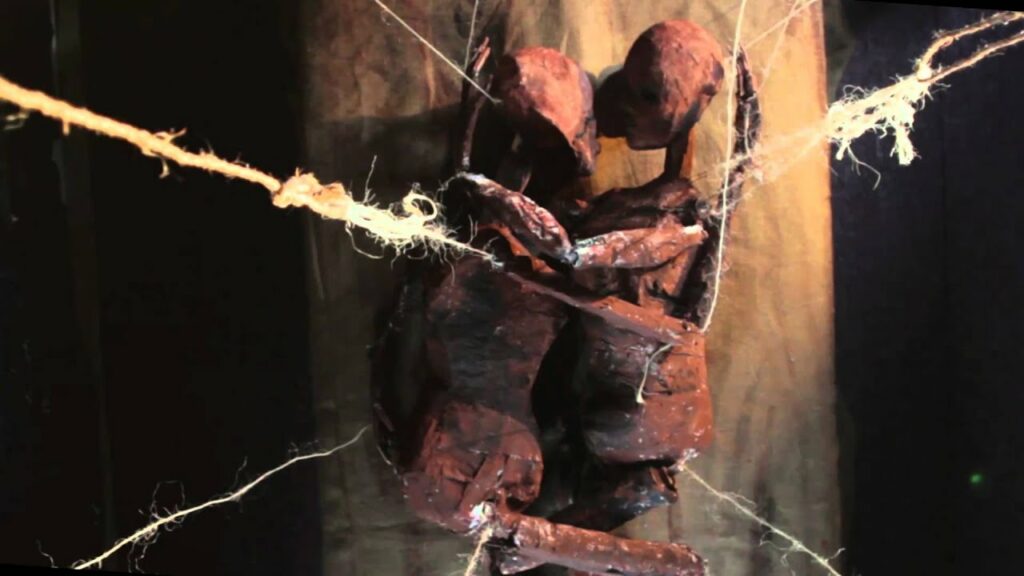Mit einem Essay von William Q. Judge
Aus dem Naturgesetz-Doppel Karma und Reinkarnation wird immer wieder die These abgeleitet, der Mensch könne auch als Tier wiedergeboren werden. Je nach Stimmung wird das als angenehm betrachtet – der Dalai Lama hat einmal scherzhaft (oder auch ernsthaft) geäußert, er würde wegen seiner Vorliebe für Honig als Biene wiedergeboren werden – oder als drohende Strafe, nach dem Motto: gelebt wie ein Schwein – wiedergeboren als Schwein.
 Wiedergeburt als Käfer? (*)
Wiedergeburt als Käfer? (*)
Wenn es so laufen würde, wäre es nicht schlecht. Etwa als Käfer wiedergeboren, hätte man ein zwar recht einfaches Leben, dafür wäre man sicher vor den Folgen der vielen Ursachen, die man als Mensch so gesät hat. Leider – oder zum Glück – ist Seelenwanderung der Art offenbar nur Aberglauben.
Einmal Mensch – immer Mensch.
Keine Regel jedoch ohne Ausnahme
Laut Weisheitslehren gilt: Einmal Mensch – immer Mensch. Keine Regel jedoch ohne Ausnahme. Wenn ein Mensch über mehrere Inkarnationen hinweg aktiv und bewusst sich am göttlichen Wesen allen Seins vergeht, wird er früher oder später seines seelischen Prinzips verlustig werden. Am Ende steht die völlige Annihilation des seelischen Prinzips. Bis dahin gilt jedoch: Da solche Menschen zumeist eine extrem starke Erdbindung besitzen – und eine damit verbundene Gier nach sinnlicher Existenz – werden sie weiterhin als Mensch wiedergeboren. Jedoch in immer erniedrigendere Umstände, die im übertragenen Sinne tierähnlichen Charakter haben. Hier scheint ein Aspekt des Mythos von der Seelenwanderung seinen Ursprung zu haben.
Ein weiterer Aspekt: Was passiert mit den Atomen, die zeitlebens unsere äußere Form gebildet haben, nach unserem physischen Tod? Diese kleinen Entitäten sind durch und durch mit unserem Magnetismus durchtränkt. Nach der Auflösung der physischen Form dienen sie zum Aufbau neuer Formen. Somit kann etwa ein Wassermolekül, das einst zu unserem Körper gehörte, nach unserem Tod unseren Magnetismus auf eine tierische Form übertragen, wenn es in einem Tier absorbiert werden sollte. Das ist eine sehr subtile Form von karmischer Wirkung. Angeblich soll hier eine der Ursachen liegen, warum manchmal Tiere unvermittelt Menschen anfallen… Der irisch-amerikanische Theosoph und Mystiker W. Q. Judge hat alle relevanten Aspekte hierzu gut verständlich im nachfolgenden Essay zusammengefasst.
TRANSMIGRATION OF SOULS
By William Q. Judge
„Is there any foundation for the doctrine of transmigration of souls which was once believed in and is now held by some classes of Hindus?“ is a question sent to The Path.
From a careful examination of the Vedas and Upanishads it will be found that the ancient Hindus did not believe in this doctrine, but held, as so many theosophists do, that „once a man, always a man,“ but of course there is the exception of the case where men live bad lives persistently for ages. But it also seems very clear that the later Brahmins, for the purpose of having a priestly hold on the people or for other purposes, taught them the doctrine that they and their parents might go after death into the bodies of animals, but I doubt if the theory is held to such an extent as to make it a national doctrine. Some missionaries and travelers have hastily concluded that it is the belief because they saw the Hindu and the Jain alike acting very carefully as to animals and insects, avoiding them in the path, carefully brushing insects out of the way at a great loss of time, so as to not step on them. This, said the missionary, is because they think that in these forms their dead friends or relatives may be living.
The real reason for such care is that they think they have no right to destroy life which it is not in their power to restore. While I have some views on the subject of transmigration of a certain sort that I am not now disposed to disclose, I may be allowed to give others on the question „How might such an idea arise out of the true doctrine?“
First, what is the fate of the astral body, and in what way and how much does that affect the next incarnation of the man? Second, what influence has man on the atoms, millions in number, which from year to year enter into the composition of his body, and how far is he – the soul – responsible for those effects and answerable for them in a subsequent life of joy or sorrow or opportunity or obscurity? These are important questions.
The student of the theosophic scheme admits that after death the astral soul either dies and dissipates at once, or remains wandering for a space in Kâma Loca. If the man was spiritual, or what is sometimes called „very good,“ then his astral soul dissipates soon; if he was wicked and material, then the astral part of him, being too gross to easily disintegrate, is condemned, as it were, to flit about in Kâma Loca, manifesting itself in spiritualistic séance rooms as the spirit of some deceased one, and doing damage to the mental furniture of mortals while it suffers other pains itself. Seers of modem times have declared that such eidolons or spooks assume the appearance of beasts or reptiles according to their dominant characteristics. The ancients sometimes taught that these gross astral forms, having a natural affinity for the lower types, such as the animal kingdom, gravitated gradually in that direction and were at last absorbed on the astral plane of animals, for which they furnished the sidereal particles needed by them as well as by man. But this in no sense meant that the man himself went into an animal, for before this result had eventuated the ego might have already re-entered life with a new physical and astral body. The common people, however, could not make these distinctions, and so very easily held the doctrine as meaning that the man became an animal. After a time the priests and seers took up this form of the tenet and taught it outright. It can be found in the Desâtir, where it is said that tigers and other ferocious animals are incarnations of wicked men, and so on. But it must be true that each man is responsible and accountable for the fate of his astral body left behind at death, since that fate results directly from the mans own acts and life.
Considering the question of the atoms in their march along the path of evolution, another cause for a belief wrongly held in transmigration into lower forms can be found. The initiates could teach and thoroughly understand how it is that each ego is responsible for the use he makes of the atoms in space, and how each may and does imprint a definite character and direction upon all the atoms used throughout life, but the uninitiated just as easily would misinterpret this also and think it referred to transmigration. Each man has a duty not only to himself but also to the atoms in use. He is the great, the highest educator of them. Being each instant in possession of some, and likewise ever throwing them off, he should so live that they gain a fresh impulse to the higher life of man as compared with the brute. This impress and impulse given by us either confer an affinity for human bodies and brains, or for that which, corresponding to brutal lives and base passions, belongs to the lower kingdoms. So the teachers inculcated this, and said that if the disciple lived a wicked life his atoms would be precipitated down instead of up in this relative scale. If he was dull and inattentive, the atoms similarly impressed traveled into sticks and stones. In each case they to some extent represented the man, just as our surroundings, furniture, and clothing generally represent us who collect and use them. So from both these true tenets the people might at last come to believe in transmigration as being a convenient and easy way of formulating the problem and of indicating a rule of conduct.
(The Path, Vol. V, March, 1891, pp.383-84)
(*) Text/Bild: Heinz Knotek
Zuletzt aktualisiert: 14.01.2012 von Heinz Knotek






